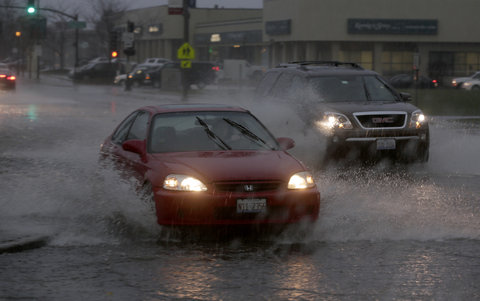- The median age for U.S. homes is 37 years — getting up there when it comes to handling todays unpredictable weather.
- Ninety-nine percent of American houses leak and consume too much energy, says Energy Star, and that contributes to carbon pollution.
Both factors can make a home more expensive to heat and cool, and vulnerable to cold snaps, heat waves, and severe storms. That, in turn, can negatively affect a homes worth. But a few value-adding improvements provide some peace of mind. Heres what can you do to protect your investment.
1. Tackle Sweltering Weather
Why: Unseasonably warm weather may reduce your heating bill in winter, but during the summer it can spell higher cooling costs.
How: Install a cool roof. It can make your home more comfortable when the temperatures spike. A traditional dark-colored roof can heat up to almost 190 degrees, creating sweltering indoor conditions. A lighter-colored cool roof stays 50 to 100 degrees cooler since it reflects sunlight instead of absorbing heat. As an added bonus, keeping your roof cooler can extend its life.
There are a ton of roofing materials. Among the options:
- Cool roof coating. Its like a very thick white paint that can be applied to different roof types. Coatings can offer additional perks such as water and chemical protection.
- Cool-colored roofing tiles. They look like traditional tiles but have a higher solar reflectance. Tiles like these also come in a wide range of shades. Keep in mind darker colors like black will be less reflective than a lighter shade like terra cotta.
Tip: Although a cool roof can keep your home cooler during the summer, it can reduce beneficial heat gains during the winter. If you have a flat or shallow-pit roof, consider a green roof, which is either partially or completely covered in plants.
Green roofs have gained traction over the past five years because of their eco-friendly benefits.
- Natural insulators, they cut heating and cooling costs while slashing a homes carbon emissions.
- They reduce storm water runoff because plants absorb the water that would otherwise flow into the gutter.
- They provide a habitat for local wildlife in urban areas.
FYI: Proper maintenance and the right equipment can keep your home more comfortable during the summer and winter months.
- Change your HVAC filters regularly and seal the ducts to save up to 20% in energy costs.
- Properly program your thermostat. Or at least dont neglect to program it (most people never take that extra step).
- Calculate your carbon footprint with this calculator from the EPA. Itll help you identify where you can make the biggest energy reductions in your home. To get accurate results, youll need to reference energy costs from your utility bills.
2. Prepare for Power Outages
Why: Crazy weather can overload the power grid. Blackouts in the U.S. have doubled since 2003 because of freaky storms and heat waves.
How: Install a standby generator. Youll have electricity to run essential appliances and your central air system. It can even reduce your chances of flood damage by keeping your sump pump running. Its permanently installed outside your home and fueled by liquid propane or natural gas. Since its wired directly into your homes electrical system, it can automatically restore power in seconds. Price depends on the size of your home and the amount of wattage needed. A 14,000-watt model can cost around 3,300 while a 50,000-watt model can cost around 16,000.
Tip: If the ticket price is too high, you can opt for a portable generator. Theyre fueled by gasoline or propane, and are powerful enough to keep a few appliances and some lights running. Most big-box stores sell portable generators with prices starting at 299. Try the generator-buying guide from Consumer Reports for product reviews.
3. Fortify Your Home Against Wicked Winds
Why: Powerful windstorms and hurricanes can cause weak places in your home to fail. Hurricanes are responsible for eight out of the 10 most expensive natural disasters to have hit the U.S. High winds (and water) can wreck your stuff and, at worst, rip the roof off your house.
How: Make your home more impact resistant. Much of the damage from Hurricane Andrews 167-mph winds could have been prevented with proper wind protection, says FEMA. Even if you dont live in a hurricane-prone area, making your home impact resistant can protect against tornadoes and other high-wind storms. Here are ways you can windproof:
1. Add truss bracing to homes with gabled roofs, which are more prone to hurricane wind damage. The bracing uses wood beams to attach the rafters at the ends of gable roofs to boost stability.
2. Install impact-resistant windows, doors, and garage doors. These can inhibit high winds that cause structural damage from entering your home. Impact-resistant features like these come with additional perks. They can:
- Protect your home from intruders
- Reduce outside noise
- Stop warm or cool air from escaping
- Entitle homeowners to a discount on home insurance
3. Install shutters and retrofit your garage door if impact-resistant windows and doors arent in your budget. (A single window can cost as much as 600; a garage door can cost as much as 1,400.) Door and window shutters can cost as little as 5 per square foot; retrofitting your garage door to boost its hurricane resistance can cost between 150 and 500. Keep in mind, shutters and retrofitting may not be the best long term investment:
- Theyre not convenient. You have to put up the shutters and brace your garage door whenever a storm is coming, and that can be potentially dangerous. Most homeowners dont have the tools, time, or experience to properly install them.
- Although they both offer protection, they may not resist high wind pressures as effectively during Category 4 or 5 hurricanes. This is especially true for older, less wind-resistant homes, and if your garage door is made of wood.
- New windows and garage doors, in general, have more value when its time to sell.
Tip: Houses built to current codes have a better chance of withstanding a hurricane or violent windstorm. If you live along the Atlantic and Gulf coasts or in a region known for harsh, stormy weather, one of the best ways you future-proof your home is by making fortifying improvements in step with current building code requirements.
FYI: Hurricane-proofing your yard can also protect your home. Proper tree maintenance can prevent diseased or weakened branches from falling and damaging property. In addition, remove anything in your yard thats not secured in place — wind chimes, outdoor furniture, garbage cans, garden equipment, and toys — which can become projectiles.
4. Fend Off Wildfires
Why: Drought not only makes lawns look scruffy, it also creates ideal burning conditions for wildfires, especially in Western states.
How: Incorporate fire-wise landscaping. It can put a damper on kindling by limiting the amount of flammable vegetation and materials around your home.
The right materials can act as fuel breaks. Here are just a few ideas:
- Replace mulch with pebbles or gravel.
- Replace a wood deck with a concrete patio.
- Add pavers and rocks.
- Avoid fire-prone plants that have volatile oils that burn easily. One way to identify plants in the pyrophytic family: Crush their leaves to see if they produce a strong smell. Examples include: sagebrush, rosemary, and pine trees.
Tip: High-moisture annuals and perennials native to your area also are a part of a fire-wise landscape. You can find lists of plants appropriate for your area at firewise.org.
FYI: Wire mesh offers some protection by reducing the risk of nearby embers entering or hitting vulnerable parts of your home. You can use wire mesh to:
- Cover soffit, attic, and under-eave vents
- Cover openings in areas below patios, desks, and porches to prevent the collection of combustible materials like dried leaves and other flammable debris
5. Retrofit for Flooding
Why: Flooding costs homeowners big time. Just six inches of floodwater in a 2,000-square-foot home can rack up nearly 40,000 in flood damage.
How: Flood-proof your home. The best way to protect your property from flooding is with a flooding retrofit. FEMA and the National Flood Insurance Program have strict guidelines on what would work (and they arent cheap). Here are a few:
- Elevate your home so that the lowest floor is at or above flood level.
- Dry flood-proof your home so it can withstand floodwaters for at least 72 hours. This involves making the portion of a home thats below flood level watertight using materials like concrete.
- Wet flood-proof your house, which involves making changes that will allow floodwater inside a homes structure to minimize damage.
Theres also the option to relocate your home to higher ground, but thats pretty out of reach for most people.
Tip: Before you start retrofitting, make sure the upgrades you pick are in sync with local government and National Flood Insurance Program requirements. Your local flood insurance agent can help. Find yours at FloodSmart.gov.
FYI: Regular homeowners insurance doesnt cover flooding. And when you consider that almost 25% of all flood insurance claims come from moderate-to-low risk areas, you may discover you need it. You can find out what your flood risk is at FloodSmart.gov.
Related: Do You Need Flood Insurance? Finally, remember that regular preventative maintenance is the cornerstone of home protection. So if youre not cleaning your gutters or sealing your home against water and air leaks, add-ons wont make much difference.
Deirdre Sullivan is an NYC-based writer whos obsessed with maximizing every inch of her urban dwelling. Shes a former fashionista who has worked for Lucky Magazine and inStyle. She recently traded her high heels and Fashion Week pass for a drill and bandsaw. This article appeared at HAR.com at: https://www.har.com/blog_93676_5-things-every-homeowner-should-know-before-harsh-weather-hits





